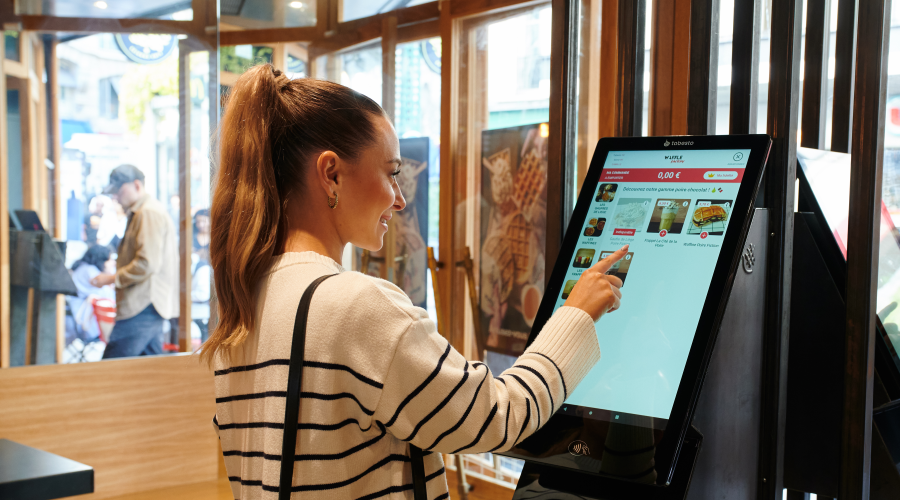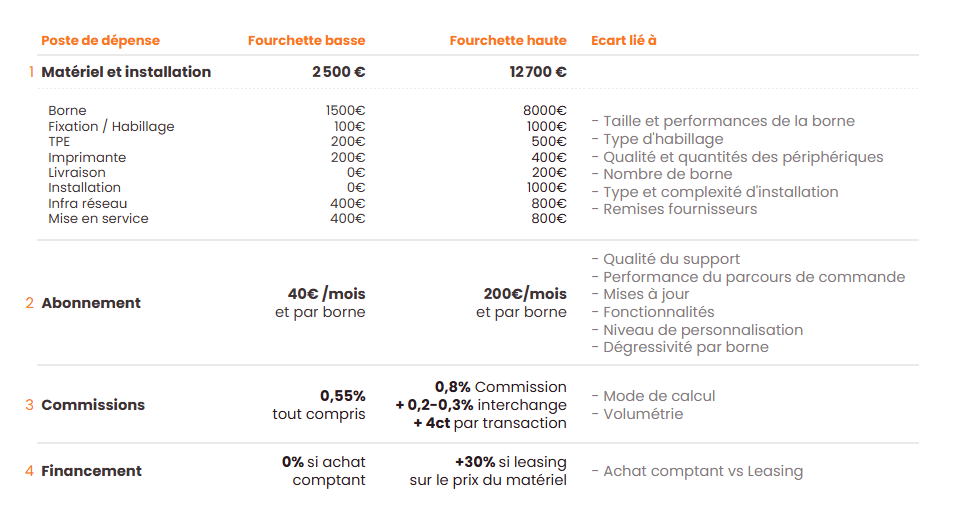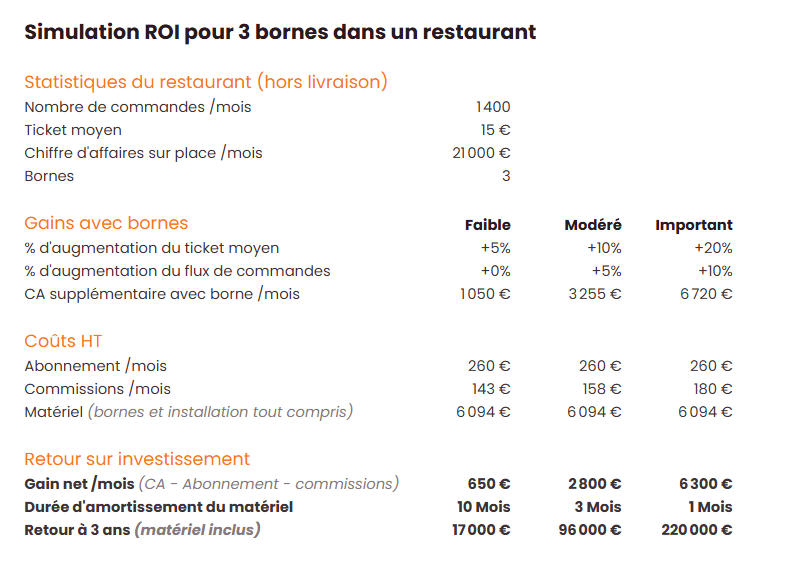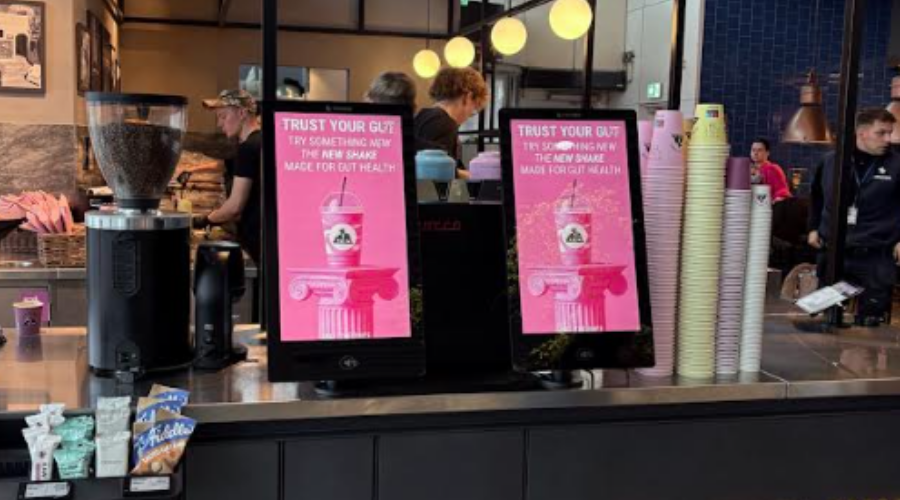What’s the cost of a self-order kiosk for restaurants
Price, subscriptions, commissions… Here’s a full breakdown of what a self-order kiosk really costs — and how it impacts your average ticket and overall revenue.

All in, expect to pay between 2,000€ and 2,500 €for a self-order kiosk installed in your restaurant, and up to 10,000€ for high-end models like those used at McDonald’s.
To that, you’ll need to add a monthly subscription (40€ to 200€ per kiosk), transaction commissions, and sometimes even indirect costs that can weigh heavily over time.
In this article, we’ll unpack every cost component so you know exactly what a kiosk really costs, how to avoid unpleasant surprises, and most importantly, how much extra revenue it can bring in.
If you’re wondering whether a kiosk is profitable, the short answer is yes, when chosen wisely, it pays for itself in just a few months. But let’s look at the details.
1. The 4 factors to calculate the price of a kiosk
The price of a kiosk is split into 4 factors:

I. Hardware
Including the kiosk and installation, you should expect around 2,500€ per unit all-in.
Entry-level kiosks can cost under 1,000€, but they come with major downsides: small screens, laggy performance, and limited ordering journeys that frustrate customers and restrict upselling.
High-quality, professional kiosks sit around 1,600€ for a 22-inch model with integrated payment like Tabesto Tap-to-Pay kiosk.
Larger, fully customisable units like McDonald’s kiosks can go up to 10,000€ each.
But a kiosk isn’t just a screen, it needs to be integrated into your restaurant. Here’s what’s usually included in your quote:
- Payment system: integrated payment (cheaper) or with a separate terminal and printer
- Network setup: to connect your kiosks to the internet
- Mounting: wall, floor stand, or countertop support
- Delivery costs: usually billed per location
- Setup fees: for menu activation and deployment in your provider’s system
Once installed, a 22-inch kiosk costs about 2,500€ for the first unit, then around 2,000€ each for additional ones thanks to shared setup costs.
You can contact our team for a custom quote.

II. Subscription
The second factor is your software plan. Behind every kiosk is a tool that must stay secure, regularly updated, and supported when needed.
Prices and service levels vary widely.
Some providers offer only basic service with slow e-mail support. Others, like Tabesto, include 7-day support, regular updates, and advanced features that help maximise your average ticket and reduce ordering time.
Generally, the cheaper the subscription, the lower the service quality and performance.
III. Commissions
Unless you use your own payment terminals, all kiosk providers charge a percentage or fixed fee per transaction, rates vary depending on the provider and hardware.
Typical rates are 0.4% to 1% + 0.03–0.05€ per transaction, plus 0.20–0.30% interchange fees in France. Some providers also charge transfer fees when you move funds to your bank account.
At Tabesto, all commissions are grouped under a single transparent rate that decreases as your sales volume grows. Your funds are transferred daily, with no hidden fees.
Because of Tabesto’s aggregated transaction volume, our rates are about 35% lower than the market average.
On 10,000€ in sales at a 15€ average ticket, a standard system costs around 100€ in fees, while Tabesto’s negotiated rates would be closer to 65€.
Tip: Don’t choose your provider based only on hardware cost. Calculate total commissions (provider + interchange) using your own revenue data, then compare three-year totals across quotes. You may be surprised.
Need help analysing your quote? Our experts can help you review it and compare it with a Tabesto kiosk.
IV. Hardware financing
Paying upfront is less expensive on the long-term but requires available cash, which isn’t always possible for recently opened or seasonal restaurants.
Leasing lets you spread payments over several years and own the kiosks at the end of the contract, though it can increase equipment cost by up to 30%.
Even with this premium, kiosks typically pay for themselves within a few months, making leasing a smart choice that remains profitable quickly.
Now let’s look at what these kiosks can actually bring in.
2. How Much Revenue Does a Kiosk Generate?
A kiosk isn’t just a cost, it’s an investment that improves your restaurant’s profitability.
At Tabesto, kiosks typically pay for themselves within three to ten months.
Profitability depends on your customer flow, menu optimisation, product photography, kiosk placement, and more.
In general, a well-chosen and well-implemented kiosk will:
- Increase your average ticket by 10% to 30% through automatic upselling
- Boost order volume by up to 10%, especially if queues currently cause lost sales
- Reduce wait times and improve customer satisfaction
- Lighten the load on your front-of-house team and increase productivity
- Modernise your restaurant’s image and attract more guests
- Serve as a marketing tool to promote special offers and drive repeat visits
Here’s an example ROI simulation for one restaurant, showing three possible impact levels, low, moderate, and high:

Even under conservative assumptions, kiosks are paid off within 3 to 10 months and generate 17,000€ to 96,000€ in additional revenue over three years after all costs.
In the most successful cases, they pay for themselves in a single month and generate over 200,000€ in three years.
If upfront payment isn’t feasible, leasing remains attractive, the extra 30% cost is easily offset by the gains kiosks deliver.
In short, the sooner you adopt kiosks, the faster your restaurant becomes more profitable, regardless of your financing model.
3. The Hidden Costs That Always Surface
On paper, quotes may look clear but in reality, some lines end up appearing later in your books, and they can sting.
Take Alex, a composite of several restaurateurs who called Tabesto after regretting their “cheaper” choice.
Alex thought they’d landed a great deal, saving 300€ per kiosk compared with other quotes. Two months later, the nightmare began.
The kiosks broke down on a busy Friday night. Support? Unavailable for three days. Queues built up, customers got frustrated, and the team couldn’t handle the rush.
Once back online, orders took forever, the interface was confusing, average ticket flatlined, and regulars started heading to the restaurant next door.
Then came the bank statement: commissions were higher than expected due to undisclosed interchange fees. The “great deal” ended up costing thousands of euros in lost margin each year.
To make matters worse, transfer fees applied every time funds were moved to the restaurant’s account. To limit damage, Alex transferred only once a week, tightening cash flow.
Two years in, the hardware was already wearing out. Performance dropped further, and replacement was imminent.
In the end, the “cheapest option” became the most expensive, and profits took the hit.
When choosing your kiosk provider, pay attention to:
- The hardware quality to ensure reliability and long-term performance
- An optimised order flow that increases average ticket and reduces wait time
- The responsiveness and quality of support
- Clear, transparent commission and transfer fees — always calculate total costs before any decision
A well-chosen kiosk isn’t an expense but an investment that pays for itself within months and continues to generate profit for years.
Every month without kiosks means missed revenue for your restaurant.
Want to equip your restaurant with self-order kiosks? Get in touch with our experts to discuss your project and receive a personalised quote.
Discover more blog posts
Discover the feedback of those who boosted their turnover and optimized their order taking


